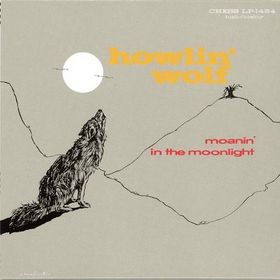In 1951, the Chess brothers purchased two singles from their newly formed associate Sam Phillips' Memphis Recording Service titled "Moanin' at Midnight" and "How Many More Years". The Chess brothers quickly moved Chester "Howlin' Wolf" Burnett and his band to Chicago. It would be a long five years before Wolf perfected another song they had recorded in 1951, then entitled "Cryin at Daybreak" into the instant classic "Smokestack Lightning," which had been within Wolfs' repertoire since the 1930's (although constantly refined). Four more years would pass before the album was fully formed and released.
This is a true blues album. From the first song (the title track Moanin' at Midnight) through both sides to the end, Wolf steals the show with his raw guttural voice and namesake howls. The primary guitarist of the album, Hubert Sumlin demonstrates the frantic yet depressed fury of notes risen from racial Southern states during the depression coupled with sudden piercing silences yet all wound around masterful and nearly reckless rythmic suspension that would later make him a major influence on several very skilled guitarists (Eric Clapton, Keith Richards, Jimmy Page, Jimi Hendrix, and Stevie Ray Vaughn all citing him so.) Willie Dixon (famed for writing several of the Chess songs that would shape the Chicago blues sound as well as working with Chuck Berry and Bo Diddly to later form the basis of Rock and Roll) is featured prominently as a bassist throughout the album. Willie Johnson (a long time Wolf collaborator and future Muddy Waters guitarist), Hosea Lee Kennard, and Earl Phillips round out the band Wolf had assembled for the majority of the album (although several other notables did work on the album as well, included Ike Turner playing piano on "How Many More Years".)
The true drawing feature of this album is the single "Smokestack Lightning" which Wolf had begun work on in the 30's. Its earlier versions featured more of a Delta blues chord structure with a slower time structure and less dominant harmonic playing (http://www.youtube.com/watch?v=Xs6cTV1L7UQ). Tweaking a few words and incorporating Sumlins' guitar lick, Smokestack Lightning quickly took shape. With the addition of standard blues piano and drum pieces, cutting back on the use of the harmonica, as well as bringing it to the forefront of the track alongside the vocals, the song is a classic example of '50s blues.
Another of my favorite songs from this is the fourth song on the second side "I asked for Water (She Gave Me Gasoline)". Although no other song compares to Smokestack Lightning in terms of listen-ability, there isnt a weak song on the album. It is, quite literally, Eleven good songs and One great song.
Overall: 10/10
I would recommend buying a Howlin' Wolf greatest hits compilation but the serious Blues affectionate would do well to invest in this album.
I wanted to throw in something like "Mixes Delta blues with Chicago blues in a previously unseen fashion" somewhere in here but I couldnt find a place or better wording. This is exactly what it does though, it is the first album, that Ive yet heard, to mix the two earliest goliaths of blues music.

No comments:
Post a Comment